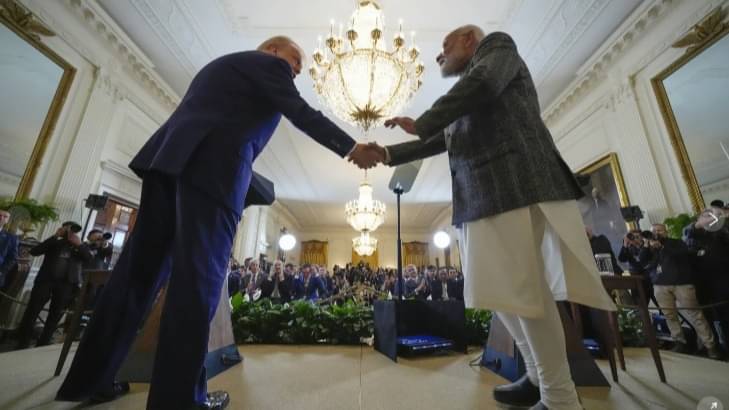India and US Partner to Develop IMEC | Image:
AP
The shifting trade alliance between the US and India has come to play a very significant role in business and economic development in both nations. The recent meetings in New Delhi over the Bilateral Trade Agreement (BTA) aimed at doubling trade to $500 billion by the year 2030. This offers great opportunities for Indian companies to expand, access new markets, and advance new concepts.
Strengthening Trade Relations
According to IBEF data, India-U.S. trade was at a high of $118.2 billion in FY24. Indian exports to the U.S. stood at $77.5 billion, reflecting the robust support of Indian industry in general across the board. Engineering goods was the largest segment at $17.6 billion, followed by electronics at $10 billion, gems and jewellery at $9.90 billion, drug formulations and biologicals at $8.72 billion, petroleum products at $5.83 billion, and readymade garments at $4.71 billion.
Indian exports to the US from April through November 2024 were worth $52.95 billion, marking a healthy growth. BTA will lower the tariffs as well as the trade barriers, and thus Indian companies can expect more market access, which will translate into their ability to compete equally in the U.S. market.
Investment Opportunities
The U.S. ranks as the third-largest investor in India, with cumulative Foreign Direct Investment (FDI) inflows worth $67.76 billion from April 2000 to September 2024.
This strong investment inflow shows that U.S. businesses have confidence in India’s business environment, allowing Indian businesses to access global money, technology, and knowledge.
Indian businesses have also invested over $40 billion in the U.S., creating over 425,000 direct jobs.
The expected BTA, however, can increase supply chains’ interdependencies and technology exchanges. This can be used to attract investments and provide opportunities for Indian players to collaborate with U.S. firms through joint ventures and partners.
Constructing global supply chains
The trade deal is focused on strengthening cooperation between the two countries in how they cooperate on supply chains. Indian companies in sectors like medicine, machinery, and electronics will benefit from this focus. For example, enhanced supply chains will reduce costs and improve efficiency, making Indian products more competitive internationally.
India exports Engineering goods (US$ 12.33 billion), Electronic goods (US$ 6.79 billion), Drugs and Pharmaceuticals (US$ 6.34 billion), Gems and Jewellery (US$ 6.28 billion), and RMG cotton and accessories (US$ 3.32 billion), etc. to US during April-November 2024, as per IBEF data.
Challenges and Strategic Opportunities
Even with a favourable outlook, Indian businesses must deal with challenges like adjusting to US standards, coping with compliance problems, and reducing trade deficits.
According to the website of the Office of the US Trade Representative, the US posted a $45.7 billion goods trade deficit with India in FY24, up 5.4% from 2023. Elements of the BTA that maintain balanced trade can help Indian exporters expand indefinitely.
In addition, industries like digital technology, renewable energy, and healthcare also offer great prospects for collaboration. With special programs under the BTA, Indian businesses can capitalize on these emerging industries to generate new ideas and market growth.

